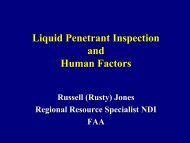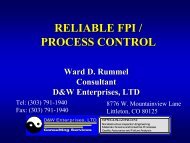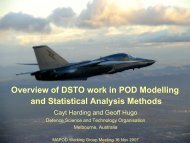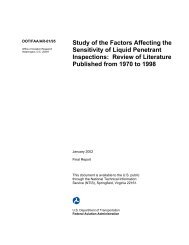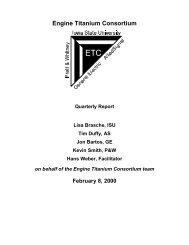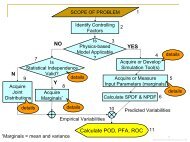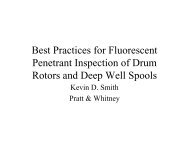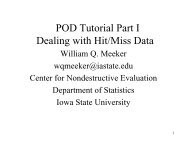Engine Titanium Consortium - Center for Nondestructive Evaluation ...
Engine Titanium Consortium - Center for Nondestructive Evaluation ...
Engine Titanium Consortium - Center for Nondestructive Evaluation ...
You also want an ePaper? Increase the reach of your titles
YUMPU automatically turns print PDFs into web optimized ePapers that Google loves.
findings <strong>for</strong> the first billet studied, the coupon manufacturing procedure will be refined as necessary<br />
<strong>for</strong> subsequent billets and <strong>for</strong>gings.<br />
Synthetic Inclusion Samples: Synthetic inclusions will be embedded into Ni test standards <strong>for</strong> the<br />
purpose of evaluating the inspection sensitivity of ultrasonics on melt-related defects. The team will<br />
review the findings from the metallurgical analysis on the naturally occurring defects to identify the<br />
candidate inclusion types <strong>for</strong> sample manufacture. Construction methods will be developed at<br />
GE-CRD to chemically manufacture the synthetic inclusions and to embed the inclusions into Ni<br />
alloy test blocks. After the successful development of synthetic inclusion manufacturing methods,<br />
three blocks containing synthetic inclusions of different geometry and composition will be<br />
manufactured. The types of inclusions will be determined by the team based on the ability to<br />
manufacture the synthetic inclusions, the criticality of the defect to part life, and the sensitivity of the<br />
inspection to the composition and geometry of the defect type.<br />
The team will ultrasonically evaluate the synthetic inclusion samples to determine the sensitivity of<br />
the inspections <strong>for</strong> detecting and characterizing melt-related defects. This data will be used <strong>for</strong> the<br />
validation of computer-based flaw models and <strong>for</strong> the generation of POD curves <strong>for</strong> Ni alloy billets.<br />
Defect Characterization: Samples will also be acquired with real defects potentially to include dirty<br />
white spots, segregation (freckles), and slag (from ESR), reflecting both VIM/VAR and<br />
VIM/ESR/VAR material defects in 718 and Waspaloy. The initial ef<strong>for</strong>t will focus on evaluation of<br />
natural defects to establish typical compositions and properties and their detectability. Six samples<br />
will be evaluated using a limited ultrasonic characterization and a simplified metallographic process.<br />
Ultrasonic measurements will be per<strong>for</strong>med at two stages:<br />
• original samples prior to sectioning<br />
• defects machined to regular shapes<br />
Characterization data will be used to optimize the inspection development ef<strong>for</strong>ts of 1.1.2, provide<br />
data <strong>for</strong> validation of flaw models and provide input <strong>for</strong> generation of POD <strong>for</strong> nickel billet in 3.1.1.<br />
Results will be included in the final report.<br />
Objective/Approach Amendments: Objective and approach remain as originally proposed in July<br />
1998.<br />
Progress (January 1, 2002 – March 31, 2002):<br />
Several consortium conference calls were conducted during the quarter to discuss the details of the<br />
subtask. A number of technical issues were discussed and decisions reached. The technical<br />
issues and discussions are summarized into two primary areas, (1) Property Measurements, and<br />
(2) Metallographic Microstructure which are discussed separately below.<br />
Property Measurements<br />
A primary goal of the Ni billet Fundamental Studies subtask is to determine, <strong>for</strong> representative Nialloy<br />
billets, the manner in which ultrasonic properties depend on inspection direction and position<br />
within the billet. The inspection properties of interest are the sonic velocity, attenuation, and<br />
backscattered grain noise level, with the latter two properties strongly dependent on the inspection<br />
frequency. Results of the property measurements will later be used by the Production and<br />
Quarterly Report – January 1, 2002 –March 31, 2002<br />
print date/time: 6/6/2002 - 8:39 AM – Page 4



